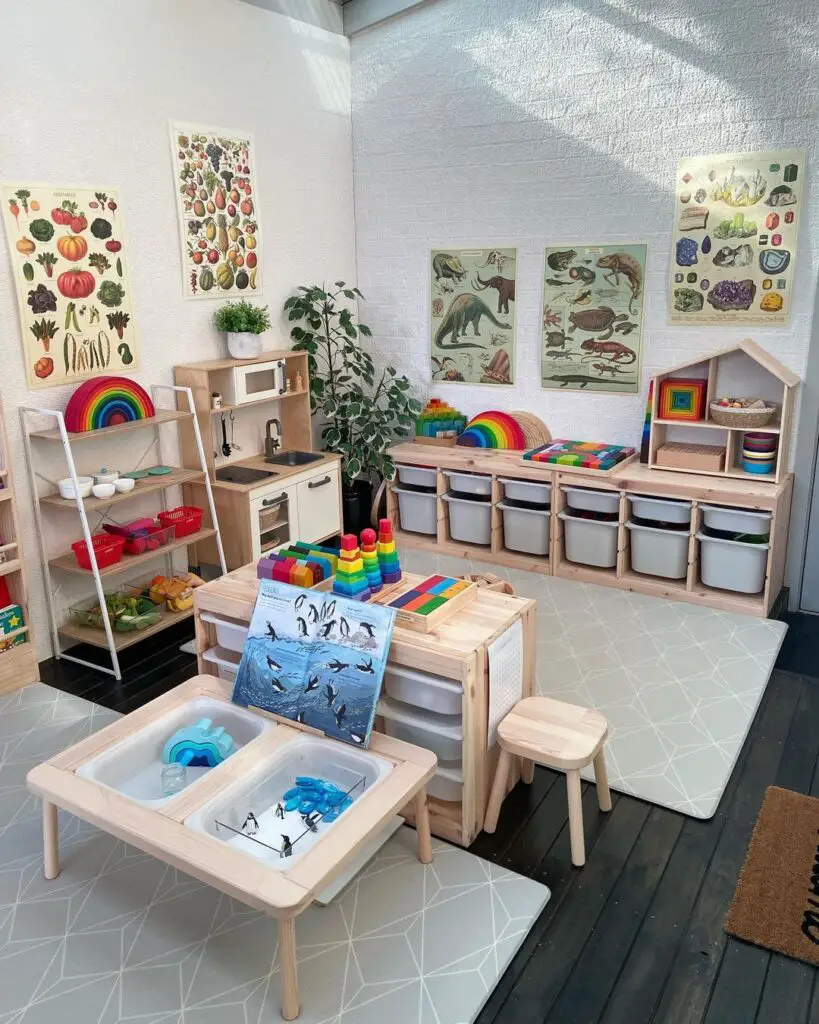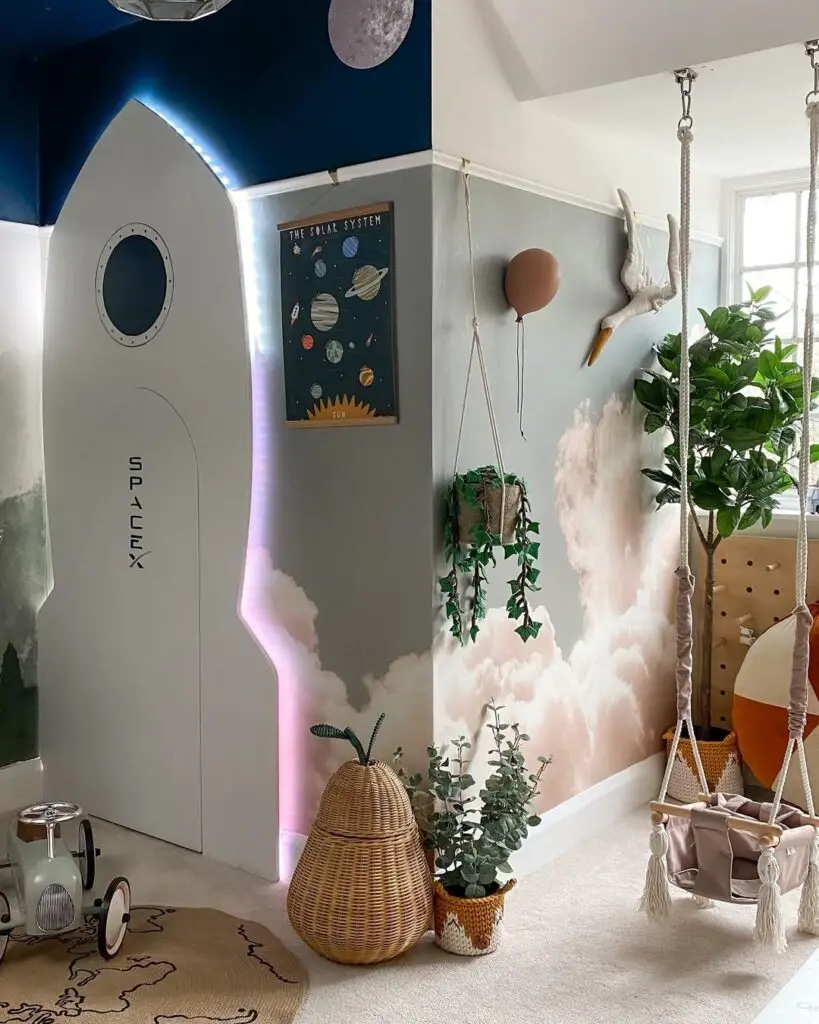
Introduction
Designing a playroom for your children is an exciting endeavor. It’s a space where they can unleash their creativity, explore their imaginations, and have endless hours of fun. However, creating a playroom that strikes the perfect balance between functionality and playfulness can be a challenge. In this article, we will explore various playroom design ideas that will help you transform a simple room into a magical world for your little ones.
Playroom Design Ideas
Here are some fantastic playroom design ideas that will inspire you to create an enchanting space for your kids:
1. Colorful Wall Decals: Unleash Imagination
Add a touch of whimsy to the playroom by adorning the walls with colorful wall decals. Choose decals that depict their favorite characters, animals, or even landscapes. These easy-to-apply stickers not only bring life to the walls but also serve as a canvas for imaginative play. Your children can create stories and scenarios around the characters on the wall, fostering their storytelling abilities.
2. Sensory Play Corner: Engage Their Senses
Include a sensory play corner in the playroom to engage your children’s senses. Set up a mini sand table where they can dig, build sandcastles, and explore textures. Incorporate a water table for splashing fun and experiment with different water toys. Don’t forget to add a soft rug or foam mats for comfortable playtime.
3. Cozy Reading Nook: Encourage a Love for Books
Create a cozy reading nook where your children can dive into the magical world of books. Set up a comfortable seating area with soft cushions, bean bags, or a small couch. Install wall-mounted shelves to display their favorite books, making them easily accessible. Make the reading nook inviting by incorporating warm lighting and adding plush stuffed animals.
4. Interactive Wall Art: Merge Art and Play
Turn the playroom walls into an interactive art gallery by installing magnetic or chalkboard paint. Magnetic walls allow kids to display their artwork with magnets, while chalkboard walls encourage doodling and creativity. These interactive elements not only enhance the visual appeal of the playroom but also provide an outlet for self-expression.
5. Playful Storage Solutions: Organize with Style
Keep the playroom tidy and organized by incorporating playful storage solutions. Use colorful bins, baskets, or cubbies to store toys, books, and art supplies. Label each storage container with pictures or words to help your children learn and practice organization skills. Opt for furniture pieces with hidden storage compartments to maximize space.
6. Indoor Climbing Wall: Reach New Heights
Install an indoor climbing wall to add an element of adventure and physical activity to the playroom. Climbing walls help develop your children’s motor skills, balance, and coordination. Ensure the climbing wall is age-appropriate and designed with safety in mind. Include crash mats or foam padding to prevent injuries.
7. Pretend Play Area: Unleash Creativity
Designate a specific area in the playroom for pretend play, where your children can let their imaginations run wild. Create a dress-up corner with costumes, hats, and accessories. Set up a play kitchen complete with mini appliances and utensils. Add a small table and chairs for tea parties or make-believe picnics. Encourage role-playing and storytelling to foster creativity and social skills.
8. Wall-Mounted Art Display: Showcase Masterpieces
Display your children’s artwork proudly with a wall-mounted art display. Install a wire or string across the wall and use clothespins or clips to hang their drawings, paintings, and crafts. This not
only showcases their creativity but also boosts their confidence and self-esteem. Rotate the displayed artwork periodically to make room for new masterpieces.
9. Interactive Floor Games: Get Active Indoors
Transform the playroom floor into an interactive play area by incorporating floor games. Install a hopscotch mat, giant puzzle rugs, or interactive projection games. These games promote physical activity, problem-solving, and coordination skills while keeping your children entertained on rainy days.
10. Multi-Purpose Furniture: Maximize Space
Invest in multi-purpose furniture that maximizes space in the playroom. Look for storage ottomans that double as seating or a play table with built-in storage compartments. Opt for stackable chairs or stools that can be easily stored when not in use. These versatile pieces of furniture help keep the playroom clutter-free while providing functional solutions.
11. Craft and Art Corner: Nurture Creativity
Set up a dedicated craft and art corner in the playroom to nurture your children’s artistic talents. Include a table or easel with art supplies such as paints, brushes, markers, and colored pencils. Add a roll of paper or a whiteboard for larger-scale creations. Encourage experimentation and creative expression by allowing them to explore different art techniques.
12. Tech-Friendly Zone: Embrace Digital Learning
Incorporate technology into the playroom by creating a tech-friendly zone. Set up a designated area with a child-friendly tablet or computer loaded with educational apps and games. Choose interactive learning tools that promote cognitive development, problem-solving, and critical thinking skills. Ensure that screen time is balanced with other activities and closely monitor content to ensure age-appropriate and educational material.
13. Musical Corner: Unleash the Melodies
Create a musical corner where your children can explore their musical talents. Set up a small keyboard, a set of drums, or other age-appropriate musical instruments. Encourage them to experiment with different sounds and rhythms. Consider incorporating a mini-stage or karaoke machine for impromptu performances. Music promotes creativity, coordination, and self-expression.
14. Nature-inspired Playroom: Bring the Outdoors In
Bring the beauty of the outdoors into the playroom by incorporating a nature-inspired theme. Use wallpaper or wall decals that depict trees, animals, or landscapes. Add indoor plants or artificial greenery to create a soothing and refreshing atmosphere. Use earthy tones and natural materials for furniture and decor. This theme fosters a sense of connection with nature and encourages imaginative play.
15. Science and Discovery Center: Spark Curiosity
Designate a space for a science and discovery center in the playroom. Include a science table with magnifying glasses, microscopes, and a variety of materials for experiments. Display books and resources about different scientific topics. Encourage hands-on learning and exploration, fostering curiosity and a love for science.
16. Sensory Wall Panels: Stimulate the Senses
Install sensory wall panels in the playroom to provide tactile and visual stimulation. Incorporate elements such as textured surfaces, mirrors, buttons, and sensory toys. These panels engage different senses and promote sensory development and exploration.
17. Lego Wall or Building Station: Build and Create
Dedicate a wall or area for a Lego wall or building station. Mount baseplates on the wall or provide a large table for building Lego creations. Organize Lego sets and bricks in labeled containers for easy access. This encourages creativity, problem-solving, and fine motor skills development.
18. Movie Theater Corner: Movie Magic at Home
Create a cozy movie theater corner in the playroom for family movie nights or rainy day screenings. Install a projector or large-screen TV and set up comfortable seating with bean bags or a small sofa. Add
blackout curtains or shades to create a theater-like atmosphere. Complete the experience with popcorn and snacks.
19. Indoor Playhouse or Fort: Create a Hideaway
Build an indoor playhouse or fort where your children can have their own private hideaway. Use curtains, sheets, or cardboard to create the structure. Fill it with pillows, blankets, and stuffed animals for a cozy retreat. This provides a space for imaginative play, quiet time, or secret club meetings.
20. Wall-Mounted Activity Board: Develop Motor Skills
Install a wall-mounted activity board in the playroom to develop your children’s fine motor skills. Include elements such as gears, switches, knobs, and latches that require manipulation. This interactive board helps improve hand-eye coordination, problem-solving, and concentration.

FAQs about Playroom Design
- Q: How do I choose the right theme for my playroom design?
- A: When selecting a theme, consider your children’s interests, favorite colors, and their preferred play activities. Incorporating elements from their favorite books, movies, or hobbies can create a space they will love.
- Q: How can I make the playroom safe for my children?
- A: Ensure that all furniture and equipment are childproofed and free from sharp edges. Secure heavy furniture to the wall to prevent tipping. Use non-toxic paint and materials. Install safety gates if needed and regularly inspect toys for any hazards.
- Q: Should I involve my children in the playroom design process?
- A: Involving your children in the design process allows them to express their preferences and fosters a sense of ownership. Ask for their input when choosing colors, themes, and decorations.
- Q: How can I incorporate educational elements into the playroom design?
- A: Integrate educational elements such as alphabet charts, numbers, and educational games. Use educational posters and interactive toys that promote learning while having fun.
- Q: How do I create a playroom that grows with my children?
- A: Opt for versatile furniture and storage solutions that can be easily adapted as your children grow. Consider neutral color schemes that can be easily modified with accessories and decorations.
- Q: What type of lighting is suitable for a playroom?
- A: Natural light is ideal, so maximize window space if possible. Add layered lighting with ceiling fixtures, floor lamps, and table lamps to create a warm and inviting ambiance. Dimmer switches allow you to adjust lighting levels for different activities.
Conclusion
Designing a playroom is a wonderful opportunity to create a space where your children can learn, grow, and have endless hours of fun. By incorporating these playroom design ideas, you can transform a simple room into a magical haven for your little ones. Remember to choose themes and elements that align with their interests, prioritize safety, and create a functional and organized space. Let your imagination run wild and watch as your playroom becomes the ultimate playground for your children.


